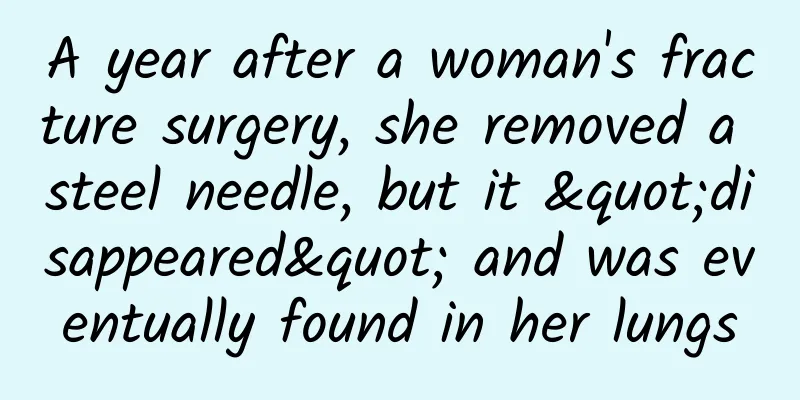A year after a woman's fracture surgery, she removed a steel needle, but it "disappeared" and was eventually found in her lungs

|
Ms. Wang, 30, suffered a broken clavicle one year ago. After being hospitalized, the doctor performed an open reduction and Kirschner wire fixation on her. However, it was this operation that led her to undergo an even more serious operation and even more severe anesthesia a year later. This story has to start from the day of the operation: the doctor who performed the operation on her was a doctor with low technical ability but high emotional intelligence. To put it bluntly, he was the kind of doctor who was very talkative but had poor technical skills. Thinking that she was going to have a clavicle fracture surgery, Ms. Wang did not specifically choose a doctor. She just looked at the rows of photos of experts on the wall and randomly chose one. Of course, it was still difficult for her to know who was a master just by looking at the introduction. Before the operation, when she saw the amiable doctor, she felt that she was lucky. So she followed the instructions and went on the operating table. When Dr. Li from the Department of Anesthesiology saw that the surgery was performed by this orthopedic surgeon, he was overwhelmed because his mouth was really unbearable. For clavicle fractures, brachial plexus block anesthesia is usually chosen unless there are special circumstances. So, Dr. Li fixed the problem with one shot. After the anesthesia took effect, Ms. Wang felt that she couldn't lift her arm. She was a little worried and asked why this happened. After Dr. Li explained that this was a normal effect of anesthesia, she stopped worrying. During the operation, this chatterbox was really busy. He kept talking from beginning to end. At first, Ms. Wang thought this would help reduce her nervousness. Later, her ears started buzzing. She looked up and saw that the anesthesiologist had already hidden far away. Although he was hiding far away, Dr. Li had everything in the operating room in his mind. Not only the monitor, but also every move on the stage could not escape his eyes. Seeing Ms. Wang looking up and around several times, Dr. Li guessed that she was irritated. This happened more than once. So, he injected a sedative and Ms. Wang fell into a deep sleep. Without an audience, the orthopedic surgeon could only hold back all his words. Even when Dr. Li approached to observe the situation in the surgical area, he stopped talking. Since the operation was not very difficult, the Kirschner wires were inserted in about an hour. After the operation was over, the doctor patted Ms. Wang on the shoulder. Ms. Wang opened her eyes and asked: Is the operation completed? The orthopedic surgeon finally had an audience, and he started his mode: In order to prevent a bulge on your clavicle, the exposed part of the Kirschner wire is not bent. If it is bent, a bulge may form on the skin, which will not look good when you wear clothes. Although he felt something was wrong, Dr. Li had no choice but to prepare to leave the operating room. Generally speaking, whoever performed the surgery the first time would also be the one who removed the nail the second time. So, one year later, Ms. Wang was lying on his operating table again. However, what was unexpected was that the operation that was supposed to be completed in half an hour turned into nearly two hours. During the operation, the Kirschner wire that was supposed to stay in the clavicle disappeared. The panicked orthopedic surgeon immediately asked their chief for help. When the chief director arrived, he immediately discovered the situation: he believed that this strange Kirschner wire might have slipped into the lungs. After this reminder, Ms. Wang, who was still conscious, recalled that she did experience dull pain in the left chest and mild cough after the operation. Because it was not serious, she did not think much about it. At this point, Dr. Li didn't know whether to feel relieved or sympathetic. Because, in the orthopedic department, they never take X-rays when removing Kirschner wires. They said confidently: The Kirschner wire is right there, how could it fly away? No wonder, under normal circumstances, it will come out by cutting open the skin. Unexpectedly, this time it really "flew away"! There is no choice but to change the anesthesia to general anesthesia. Doctor Li was also caught off guard, but fortunately when signing before the operation, he told her that the procedure might be changed to general anesthesia. An hour later, with the help of thoracoscopy, the Kirschner wire was successfully found. Fortunately, the Kirschner wire had just penetrated into the lung lobe, and most of it was still in the clavicle. If it had completely "fallen" into the chest cavity, the consequences would have been disastrous. Since then, all Kirschner wire removal surgeries have included preoperative films. There are many cases where preoperative examinations are omitted, but few people know that every diagnosis and treatment process is a summary of countless painful experiences and lessons! [Warm Tips] Follow us, there are a lot of professional medical knowledge here, revealing the secrets of surgical anesthesia for you~ |
<<: How to Correctly Use “Cold and Hot Compresses” for Bone and Joint Diseases
Recommend
Where do crocodiles live? Why do crocodiles shed tears?
Crocodiles are the oldest reptiles that lived at ...
Normal secretion examination report
Understanding the routine physical examination re...
How to tell if a woman just had sex
In the process of dating, men and women need to b...
What should I do if I have a strong erection but no ovulation?
For many people, the symptoms of anovulation in w...
Can I get HPV from swimming?
Speaking of HPV, this is a virus that is extremel...
Overdrawn kidneys cannot be replenished! Many people are doing these 5 kidney-damaging behaviors!
In our country, one in 10 people suffers from kid...
There is a small meat picture on the vulva
Regardless of the age of women, the private parts...
How to start early in late pregnancy
Pregnancy is a very long stage, especially in the...
The cause of irregular menstruation is actually because of this matter
In addition to causing inconvenience to women, ir...
Right breast pain like a needle prick
Some women find that they often have a tingling p...
Ointment for vulvar itching
Vulvar itching is a relatively common gynecologic...
How many days of pregnancy will the breasts react
Generally, if you feel it quickly after having se...
What is the problem of watery leucorrhea like tofu residue?
Women should learn to observe the symptoms of the...
What anti-inflammatory drugs to take for vaginal swelling and pain
There are many patients with gynecological diseas...
Will a small cervix affect fertility?
Generally speaking, a small cervix will not affec...









